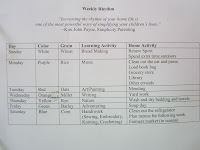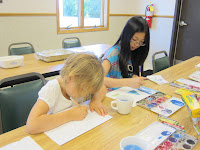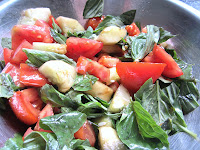Originally, it was a four-week planning session. However, it has since expanded to eight weeks. The original participants went through the four-week planning process; and then could choose to begin again. This has been helpful to re-visit some of the earlier topics covered and fill in sections that I didn't have time to address during the first process.
At any rate, the focus of the class was an exploring the rhythm of the year in the context of planning a homeschool year. We began by getting a planner. I had several on hand, so I picked a small, maroon 3-ring binder. I added a pencil case and lined paper.
3-ring binder for academic work,
tabbed dividers, and a pencil case.
I also added some information I printed out from Lisa's website and links; some of the ideas from conversations on the Yahoo group set up for the class; and other ideas from the internet that focused on creating rhythm in the home and within homeschooling.
I began pinning ideas on Pinterest for different subjects:
=> Waldorf Rhythm, Routines, and Meal Times
=> Waldorf-Inspired Home
The next step was to create a school calendar. For us, that means a yearly calendar since I consider homeschooling more of a learning lifestyle than a set period of days when the girls learn. That being said, there is a "start date" and "end date" of the more "formal" homeschooling. This year, that is September 3rd and May 30th respectively.
School calendar.
Normally, we go on a "not back to school" trip the day after Labor Day for a few days. This year, however, we will not be going on a trip. Instead, we will do a "not back to school picnic" on September 3rd - the day after Labor Day.
Also on the calendar are days that there are no school or a holiday. This year on holidays we will focus on activities related to the holiday rather than doing traditional school work.
The calendar also shows birthdays and anniversaries (e.g., Adoption Days); breaks; and when we start and end the time period where we focus more on alternative ways to learn (e.g., 4-H, county fair, state fair).
Wheel of the Year.
Next, I looked at the different holidays that we will be celebrating and learning about this year; and found pins on Pinterest for them. We will be celebrating additional holidays and special days (e.g., New Year' Day, Mother's Day), but these are the core ones that had quite a few ideas that I wanted to remember.
JANUARY
=> Epiphany
=> Tu B'Shevat
=> Chinese New Year
FEBRUARY
=> Brigid's Day
=> Candlemas
=> Groundhog's Day
=> Valentine's Day
MARCH
=> Mardi Gras
=> Lent
=> St. Patrick's Day
=> Spring Equinox
APRIL
=> Passover
=> Easter
MAY
=> May Day
=> Memorial Day
JUNE
=> Pentecost or Whitsun
=> Summer Solstice
=> St. John's Tide
JULY
=> Fourth of July
AUGUST
=> Lammas
SEPTEMBER
=> Labor Day
=> Autumn Equinox
=> Rosh Hashana
=> Michaelmas
OCTOBER
=> Yom Kippur
=> Halloween
NOVEMBER
=> All Saints Day
=> All Souls Day
=> Martinmas
=> Adoption Day Celebrations
=> Chanukah
=> Thanksgiving
DECEMBER
=> Advent
=> St. Nicholas Day
=> St. Lucia Day
=> Las Posadas
=> Winter Solstice
=> Christmas Eve and Day
=> 12 Days After Christmas
=> New Years Eve
Monthly activities on a circular calendar.
I created a wheel of the year after I found a pin that I liked. using a free PDF pattern from Daily Colours.
Then I looked at the weekly rhythm that I would like to start doing this year. Some of the ideas are based on Rudolph Steiner's beliefs and/or what some families using a Waldorf methodology/lifestyle follow (e.g., color of the day, grain of the day) while others are what works best for our family.
Rhythm of the week.
I noted the color of the day, grain of the day, activity of the day that involves Sophia and Olivia, and an activity of the day for me. Some of the activities that I do, the girls can help (e.g., Soup Day), but most are personal things that I want or need to get done.
SUNDAY
=> White
=> Wheat
=> Bread Making
=> Renew the Spirit
MONDAY
=> Violet
=> Rice
=> Music
=> Errands
TUESDAY
=> Red
=> Oats
=> Art and Painting
=> Mending
WEDNESDAY
=> Orange
=> Millet
=> Writing
=> Yard Work
THURSDAY
=> Yellow
=> Rye
=> Nature
=> Wash and dry bedding + towels
FRIDAY
=> Green
=> Barley
=> Adventuring (field trips, visit my mom, volunteering at the nursing home)
=> Soup Day
SATURDAY
=> Blue
=> Corn
=> Handiwork (e.g., sewing, embroidery, crocheting, knitting)
=> Menu Planning (also includes cleaning out the refrigerator)
Daily activities on a circular weekly calendar.
Once the color of the days were set, I thought that the best way to implement that was by having them be a part of the meal. For example, it may be the color coasters, place mats, tablecloth, table runner, and/or candles that we use.
I also looked on Pinterest for ideas for food that incorporates the different grains. I was surprised at the lack of recipes for millet. Apparently it's an under-rated grain.
I also made a rhythm of the week wheel. Daily Colours (the website mentioned above) has a free PDF pattern. However, I ended up using only the back and pointer. The colors on Wednesday and Thursday were the reverse of what I wanted to do in my family. (I prefer the flow of red-orange-yellow-green rather than red-yellow-orange-green since it follows the look of a rainbow.)
So, I made the circle and divided it into seven sections. I wrote the daily information into each section, and then colored in each part with the appropriate Prismacolor colored pencil.
One of the other things I did that ties into both the monthly holidays and special days; and the weekly grains was go through a binder that I have with lots of recipes that I would like to try. The recipes were divided by type (e.g., appetizer, main dish, bread, vegetables). This did not lend itself well to easily finding recipes.
To address this challenge, I went through all the recipes and pulled out ones that I'd like to try during a particular month, at a specific holiday/special occasion, or that included the grain of the day.
After the recipes were divided, I put each grouping into a plastic sheet protector. In this way, I can easily find recipes that use peaches, for example, since they are in the August sheet protector. (This is the month that peaches are readily available in Minnesota.)
The next step for me was to figure out what to teach on a daily basis. Honestly, this is where I got stuck for well over a week. The girls each have some work left to do from the 2012-13 school year. Since they enjoyed what they were doing, I wanted to continue with it into this year. There were other subjects or activities that I let go in favor of new ones that we will be adding this year.
The other challenge is that funds are quite limited this year. That means there is no extra money to purchase curriculum that I would like to try. Rather, I went through the resources I have on hand as well as look at free resources online to create the curriculum for the 2013-14 homeschool year.
A page from Sonlight's curriculum.
This is the one that Sophia will be finishing this year.
Already, there is quite a bit done on this particular week.
As I have done in the past, I look at the girls' interests, skill levels, educational levels, and learning styles. Although both girls have a strong interest in reading and literature, Sophia has done particularly well with Sonlight's curriculum.
Page from Sonlight's science curriculum schedule.
Thankfully, Sonlight includes so much into one level of of curriculum, that it can be stretched out into 1 1/2 - sometimes 2 years. In Sophia's case, she will complete what she started last year by January 2014. At that point, she will move onto Ambleside Online since it's a free curriculum and follows Charlotte Mason's educational philosophy.
Page of Ambleside Online's schedule for Olivia.
Olivia will be starting with Ambleside Online in September. Since she is working with the local elementary school to receive assistance with some learning, auditory processing, and short-term memory issues, some of her subjects are covered in a way that works well for her: through workbooks.
This is quite a different path than both a Waldorf and Charlotte Mason approach, however, for Olivia it works well. The workbooks are supplemented by "living books" from the library which gives her some quality reading on subjects addressed in the workbooks.
She also will be doing Beyond Five in a Row. During the first semester, she'll be working on four books (two fiction and two non-fiction). There are a wide variety of hands-on activities for her to which she is looking forward to doing.
One of the pages in the planning binder.
There are three of these per week -
each row has a different subject.
In addition, the girls each have a variety of subjects that they learn about during the year:
A to Z Book (Olivia is creating a book about different subjects that begin with each letter of the alphabet)
Art
Character Education
Foreign Language (French for Olivia; Spanish for Sophia)
Grammar
Handwriting (standard for Olivia and Spencerian for Sophia)
Holidays
Journaling
Latin/Greek (Sophia only)
Literature (listen to 1 Newberry award book per month)
Math
Music (piano for Olivia; piano, harp, and violin for Sophia)
Nature Journaling
Physical Education (sports, equine vaulting, dog training, dog agility training - not all at the same time)
Poetry
Religion
Science
Service/Volunteering
Social Studies (includes geography and history)
Speech Therapy (Olivia only)
Spelling
Typing
U.S. Geography
Vocabulary
Writing
4-H
Another page with more subjects
that the girls will study in the 2013-14 school year.
Using free printable sheets from Donna Young's website, I did a plan for these subjects as well as using Sonlight's, Ambleside Online's, and Beyond Five in a Row's schedules for 9 weeks. This will take us to November 2nd. At that time, I will complete another 9 weeks of planning based on what has and hasn't been completed. I have the schedule for the academic portion of the girls' year in a purple 3-ring binder. There are tabbed-dividers that separate the plans by week.
One of the many types of planning sheets
available from the Donna Young website.
The last component of planning for the upcoming home- and homeschooling year including creating a larger binder with non-academic subjects and home management items.
Binder with non-academic subjects and
home management items.
Organized Home has many free printables that will be invaluable this year in terms of keeping organized. The tabbed sections in the white 3-ring binder include:
- Contact numbers - includes emergency numbers, frequently-used numbers, and a list of birthdays/anniversaries
- Menu planning - this has a plan for theme dinners when things get a bit more hectic and we don't want to spend a lot of time in the kitchen, or making meals for various school subjects (e.g., meals that focus on different states, meals from Beyond Five in a Row).
Some of the meal themes dovetail nicely with the grain of the day. For example, on Monday the grain is rice so I chose "Asian Night" as the theme. On Saturday, the grain is corn so I thought "Mexican Night" might fit well. Here is the weekly plan:
Sunday - Sunday Dinner - meat with potatoes and carrots. The leftover meat can be used for sandwiches during the week. Have a very light meal in the evening if anyone is hungry (e.g., cheese, crackers, fruit).
Monday - Asian Night
Tuesday - Crockpot Night
Wednesday - Pasta Night
Thursday - Leftovers
Friday - Soup Night with Fresh Bread
Saturday - Mexican Night
I've also included several printables from Organized Home in this section including weekly and monthly meal planners.
Shopping List - Copies of a shopping list. One will be posted in the kitchen to add to each week. In this way, when we run out of something it can be immediately added to the list.
Food Inventories - There are sheets for the freezer, pantry, and larder. The larder, in our case, is part of a closet that holds heavier canned goods (e.g., peaches, pears, tomatoes, applesauce) as well as the top shelves of a built-in bookcase that hold lighter canned goods (e.g., jams, jellies, salsa).
Recipe Locations - There are pages that have the name of favorite recipes, the cookbook/source, page number, and comments.
Monthly Rhythm - This is my chart that has five columns: month, mood, symbols/color, activities, celebrations.
One of the pages that has the monthly rhythm.
This page still needs to be retyped
so that it includes the hand-written information.
Each section has a list of the holidays and when they are in 2013-2014. I've also included some ideas, instructions, and information that relates to some of the holidays. Following that is the plastic page protector that has the recipes for the month.
This is December's section.
The first part has a list of holidays and
the second part has a sheet protector filled with recipes
that can be made for the month's holidays and celebrations.
Seasonal Chores - Organized Home has a free printable that has a fall and winter checklist; and spring and summer checklist.
Weekly Rhythms - This is the typed version of the daily color, grain, learning activity, and home activity. There also are daily to-do sheets from Organized Home.
Weekly rhythm.
Grain Sections - The next seven tabbed sections are labeled with the grain of the day - starting with wheat and ending with corn.
Protector sheet with
a variety of recipes using rice.
Patterns for Meal Time Accessories - I printed out some ideas for making tables look welcoming and pretty. There also are patterns to create napkins and place mats.
Blessings - There are some blessings I've collected that I would like to print out on cards made from watercolor paper that the girls painted.
One of the meal blessings in the binder.
Daily Rhythms - This section is a reminder of what I would like my daily rhythm to look like:
Wake up before the girls and:
- Get dressed
- Let the dogs out, take them for a walk, and feed them
- Make hot chocolate
- Write in my journal
- Start the laundry (if needed)
- Review the meals for the day, and take out anything that needs to be thawed
- Prepare breakfast
I'd like to play a board or card game with the girls each day. Integrating an element of play into each day is a goal I'd like to work on during 2013-14.
The next section focuses on family values. In terms of family values, I'd like to have the following words describe my home: contentment, love, acceptance, comfort, spiritual, truthful, generosity, helpfulness, exploring, learning, togetherness, openness, happiness, caring, compassion, wonder/discovery, reflective, excitement, enthusiasm, gratitude, and service.
The last section focuses on a family mission statement. I have a rough draft of one; and would like to work on finalizing that during 2013-14.
I also included several daily to-do lists from Organized Home. These will come in handy - especially during November-January when there is a lot to be done on a daily basis.
Daily Chores - This section has ideas for keeping a home clean. I have a proposed schedule for daily cleaning that I am interested in seeing if it will work or not this year. It is:
Sunday: Bedrooms
Monday: Mudroom
Tuesday: Offices
Wednesday: Bathrooms
Thursday: Dining Room
Friday: Living and Family Rooms
Saturday: Kitchen
Following that are more comprehensive daily chore lists that I pinned from Cedar Ring Mama. At some point during Autumn 2013, these would be nice to review and adapt to my home.
First Aid Inventory and Medicine - Organized Home has a inventory sheet for first aid supplies. I also would like to list everyone's current medications they are taking.
Bills - There are forms on Organized Home that are for each month. The top half has lines, and the bottom part has the name of the bills, date they are due, and the amount owed. There also are important dates and a monthly calendar on each sheet.
Social/Support/Craft Groups - This section will have information about any groups that the girls and I are participating in and/or leading. Once the groups begin in September, this section will have more things in it and may be sub-divided for each group.
So, what happened to the maroon binder? It has information that I still want to read, think about, and integrate into our daily lives and homeshool. This will be an ongoing resource that I can refer to, add to, and adapt the 2013-14 homeschool plan by as I make my way through the information.
Information about handiwork in the maroon binder.
I am very grateful to have taken this online class. It will add a dimension to our lives and to homeschooling that was not fully developed or - in some respects - completely absent. The plan is definitely a work in progress as I see what feels right for our family and what doesn't feel like a good fit.
























































